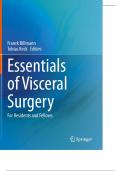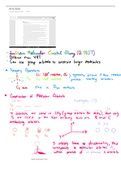Franck Billmann
Tobias Keck Editors
Essentials
of Visceral
Surgery
For Residents and Fellows
,Essentials of Visceral Surgery
,Franck Billmann • Tobias Keck
Editors
Essentials of
Visceral Surgery
For Residents and Fellows
,Editors
Franck Billmann Tobias Keck
Department of General, Visceral and Department of Surgery
Transplant Surgery University Hospital
University Hospital Heidelberg Schleswig-Holstein
Heidelberg, Germany Lübeck, Germany
1st edition under the title “Specialist knowledge in visceral and general
surgery”
This book is a translation of the original German edition „Facharztwissen
Viszeralchirurgie“ by Billmann, Franck, published by Springer-Verlag
GmbH, DE in 2021. The translation was done with the help of artificial
intelligence (machine translation by the service DeepL.com). A subsequent
human revision was done primarily in terms of content, so that the book will
read stylistically differently from a conventional translation. Springer Nature
works continuously to further the development of tools for the production
of books and on the related technologies to support the authors.
ISBN 978-3-662-66734-7 ISBN 978-3-662-66735-4 (eBook)
https://doi.org/10.1007/978-3-662-66735-4
© The Editor(s) (if applicable) and The Author(s), under exclusive license to Springer-
Verlag GmbH, DE, part of Springer Nature 2022, 2023
This work is subject to copyright. All rights are solely and exclusively licensed by the Pub-
lisher, whether the whole or part of the material is concerned, specifically the rights of
translation, reprinting, reuse of illustrations, recitation, broadcasting, reproduction on
microfilms or in any other physical way, and transmission or information storage and
retrieval, electronic adaptation, computer software, or by similar or dissimilar methodol-
ogy now known or hereafter developed.
The use of general descriptive names, registered names, trademarks, service marks, etc. in
this publication does not imply, even in the absence of a specific statement, that such
names are exempt from the relevant protective laws and regulations and therefore free for
general use.
The publisher, the authors, and the editors are safe to assume that the advice and informa-
tion in this book are believed to be true and accurate at the date of publication. Neither
the publisher nor the authors or the editors give a warranty, expressed or implied, with
respect to the material contained herein or for any errors or omissions that may have been
made. The publisher remains neutral with regard to jurisdictional claims in published
maps and institutional affiliations.
Planung/Lektorat: Fritz Kraemer
This Springer imprint is published by the registered company Springer-Verlag GmbH,
DE, part of Springer Nature.
The registered company address is: Heidelberger Platz 3, 14197 Berlin, Germany
, V
Preface
“First comes the word, second comes the medicine, and last comes the
knife”1—solid knowledge and a structured knowledge of general and
visceral surgery are obligatory prerequisites, especially for doctors in
advanced training, fellows and future specialists in general and visceral
surgery.
Medical expertise in visceral surgery and bystanding subjects has
seen a continuous and rapid increase in knowledge in recent years. The
increasing specialization in surgery has led the editors to the present
concept of a short compendium, which allows the reader to access the
current up-to-date knowledge summarized by specialists in a condensed
and clear manner.
Our book aims to provide the readers with a clear understanding of
the main aspects of general and visceral surgery. In a condensed, bullet
point form, the current and actual knowledge of visceral and general
surgery is summarized in this book, to which numerous renowned spe-
cialists have contributed in its 16 chapters.
For learning residents and fellows, special emphasis is placed on
detailed and precise recommendations concerning the diagnostic proce-
dure and the indication for therapy. The surgical procedure is described
step by step in a compact and comprehensive form. New technologies
and evidence-based treatment strategies are taken into account and
brief overviews facilitate the targeted memorization of the most impor-
tant facts. This new, completely revised second edition takes into
account the rapid development of our field on the one hand and the
high response to the book on the other.
For the preparation of the specialist examination in general surgery
or visceral surgery, the book is therefore an ideal companion as well as
a reference in everyday clinical practice.
Tobias Keck
Lübeck, Germany
Franck Billmann
Heidelberg, Germany
March 2021
1 Christian Albert Theodor Billroth (1829–1894).
,Contents
1 �Esophagus, Stomach and Duodenum.................................................�1
Torben Glatz and Jens Höppner
1.1 ��Anatomy and Physiology......................................................................................�3
1.1.1 ��Esophagus.......................................................................................................................�3
1.1.2 ��Stomach............................................................................................................................�3
1.1.3 ��Duodenum......................................................................................................................�3
1.2 ��Leading Symptoms and Diagnosis....................................................................�3
1.2.1 ��Leading Symptoms.......................................................................................................�3
1.2.2 ��Diagnosis..........................................................................................................................�4
1.2.3 ��Therapeutic Principles.................................................................................................�4
1.3 ��Benign Diseases of the Esophagus....................................................................�4
1.3.1 ��Diverticular Diseases of the Esophagus................................................................�4
1.3.2 ��Achalasia..........................................................................................................................�5
1.3.3 ��Esophageal Perforation...............................................................................................�7
1.3.4 ��Hiatal Hernias.................................................................................................................�8
1.3.5 ��Gastroesophageal Reflux Disease (GERD)............................................................�9
1.3.6 ��Guidelines........................................................................................................................�11
1.4 ��Malignant Diseases of the Esophagus.............................................................�11
1.4.1 ��Overview..........................................................................................................................�11
1.4.2 ��Esophageal Carcinoma (Including AEG)...............................................................�11
1.5 ��Benign Diseases of the Stomach........................................................................�17
1.5.1 ��Gastroduodenal Ulcer Disease.................................................................................�17
1.5.2 ��Guidelines........................................................................................................................�18
1.6 ��Malignant Diseases of the Stomach..................................................................�19
1.6.1 ��Gastric Adenocarcinoma............................................................................................�19
1.6.2 ��Gastrointestinal Stromal Tumours (GIST).............................................................�24
1.6.3 ��Guidelines........................................................................................................................�24
1.7 ��Diseases of the Duodenum..................................................................................�24
1.7.1 ��Diverticular Disease of the Duodenum.................................................................�25
1.7.2 ��Duodenal Cancer...........................................................................................................�25
1.7.3 ��Guidelines........................................................................................................................�26
References.......................................................................................................................�26
2 �Small Intestine and Appendix..................................................................�27
Didier Mutter
2.1 ��Anatomy of the Small Intestine..........................................................................�28
2.1.1 ��Measured Values............................................................................................................�28
2.1.2 ��Limits.................................................................................................................................�28
2.1.3 ��Wall Structure of the Small Intestine......................................................................�28
2.1.4 ��Circulation........................................................................................................................�28
2.1.5 ��Innervation......................................................................................................................�29
2.1.6 ��Small Intestine Functions...........................................................................................�29
2.2 ��Diseases of the Small Intestine...........................................................................�29
2.2.1 ��Clinical Presentation....................................................................................................�29
2.2.2 ��Imaging.............................................................................................................................�31
2.2.3 ��Crohn’s Disease..............................................................................................................�32
2.2.4 ��Small Intestinal Neoplasms.......................................................................................�32
, VII
Contents
2.2.5 ��Other Diseases of the Small Intestine....................................................................�35
2.2.6 ��Treatment Strategies....................................................................................................�37
2.3 ��Vermiform Appendix.............................................................................................�39
2.3.1 ��Anatomy of the Vermiform Appendix...................................................................�39
2.4 ��Diseases of the Appendix.....................................................................................�40
2.4.1 ��Appendicitis Vermiformis...........................................................................................�40
2.4.2 ��Malignant Diseases.......................................................................................................�44
References.......................................................................................................................�47
3 �Colon.........................................................................................................................�49
Oliver Thomusch
3.1 ��Anatomy and Physiology......................................................................................�50
3.1.1 ��Definition and Limits...................................................................................................�50
3.1.2 ��Tasks...................................................................................................................................�50
3.1.3 ��Location and Classification........................................................................................�50
3.1.4 ��Measured Values............................................................................................................�50
3.1.5 ��Characteristic Features of the Colon......................................................................�50
3.1.6 ��Blood Supply and Drainage......................................................................................�51
3.2 ��Benign Diseases of the Colon..............................................................................�51
3.2.1 ��Diverticulosis and Diverticulitis...............................................................................�51
3.2.2 ��Colonic Polyps................................................................................................................�56
3.2.3 ��Ulcerative Colitis............................................................................................................�57
3.2.4 ��Chronic Constipation...................................................................................................�61
3.2.5 ��Guidelines........................................................................................................................�64
3.3 ��Colon Cancer and Hereditary CRC Syndromes..............................................�64
3.3.1 ��Colon Carcinoma...........................................................................................................�64
3.3.2 ��HNPCC (Hereditary Non-polyposis Colorectal Cancer):
Lynch Syndrome............................................................................................................�71
3.3.3 ��Other Hereditary CRC Syndromes...........................................................................�75
3.3.4 ��Guidelines........................................................................................................................�75
Reference.........................................................................................................................�76
4 �Rectum.....................................................................................................................�77
Jens Wannenmacher and Stefan Willis
4.1 ��Anatomy and Physiology......................................................................................�78
4.1.1 ��Definition, Location and Structure.........................................................................�78
4.1.2 ��Anatomy and Embryology.........................................................................................�78
4.1.3 ��Physiology........................................................................................................................�79
4.2 ��Benign Diseases.......................................................................................................�79
4.2.1 ��Benign Neoplasms/Malformations.........................................................................�79
4.2.2 ��Rectal Prolapse...............................................................................................................�80
4.3 ��Malignant Diseases.................................................................................................�82
4.3.1 ��Histological Tumour Entities.....................................................................................�83
4.3.2 ��Rectal Cancer..................................................................................................................�83
4.3.3 ��Guidelines........................................................................................................................�90
Further Reading.............................................................................................................�90
,VIII Contents
5 �Anorectum.............................................................................................................�91
Jens Wannenmacher and Stefan Willis
5.1 ��Anatomy and Physiology......................................................................................�92
5.1.1 ��Anatomy...........................................................................................................................�92
5.1.2 ��Physiology........................................................................................................................�92
5.2 ��Benign Diseases.......................................................................................................�93
5.2.1 ��Hemorrhoidal Disease.................................................................................................�93
5.2.2 ��Anal Vein Thrombosis..................................................................................................�96
5.2.3 ��Anal Fissure.....................................................................................................................�97
5.2.4 ��Anorectal Abscess.........................................................................................................�99
5.2.5 ��Anorectal Fistulas..........................................................................................................�101
5.2.6 ��Pilonidal Sinus................................................................................................................�103
5.2.7 ��Fecal Incontinence........................................................................................................�105
5.2.8 ��Anorectal Voiding Dysfunction (Outlet Constipation).....................................�108
5.3 ��Malignant Disease: Anal Carcinoma.................................................................�110
5.3.1 ��Definition.........................................................................................................................�110
5.3.2 ��Epidemiology.................................................................................................................�111
5.3.3 ��Aetiology..........................................................................................................................�111
5.3.4 ��Symptomatology..........................................................................................................�111
5.3.5 ��Diagnosis..........................................................................................................................�111
5.3.6 ��Differential Diagnosis..................................................................................................�111
5.3.7 ��Therapy.............................................................................................................................�111
5.4 ��Guidelines..................................................................................................................�112
Suggested Reading......................................................................................................�112
6 �Endocrine Organs.............................................................................................�113
Franck Billmann, Courtney Elisabeth Gibson,
and Robert Udelsman
6.1 ��Anatomy and Physiology of the Thyroid Gland............................................�115
6.1.1 ��Embryology and Anatomy.........................................................................................�115
6.1.2 ��Physiology........................................................................................................................�115
6.2 ��Diseases of the Thyroid Gland............................................................................�117
6.2.1 ��Epidemiology.................................................................................................................�117
6.2.2 ��General Methods of Investigation..........................................................................�118
6.2.3 ��Basics of Surgical Therapy, Complications and Postoperative Care............�120
6.2.4 ��Benign Thyroid Diseases.............................................................................................�128
6.2.5 ��Malignant Thyroid Diseases.......................................................................................�135
6.2.6 ��Workup of a Solitary or Dominant Thyroid Nodule..........................................�138
6.2.7 ��Guidelines........................................................................................................................�141
6.3 ��Familial Malignant Syndromes of the Thyroid Gland.................................�142
6.3.1 ��Introduction (.Table 6.14)...........................................................................................�142
6.3.2 ��Hereditary Medullary Thyroid Carcinoma............................................................�142
6.3.3 ��Familial Papillary Thyroid Carcinoma (FPTC).......................................................�145
6.3.4 ��Rare Genetic Syndromes Associated with Thyroid Cancer............................�146
6.3.5 ��Guidelines........................................................................................................................�149
6.4 ��Anatomy and Physiology of the Parathyroid Gland....................................�149
6.4.1 ��Anatomy...........................................................................................................................�149
6.4.2 ��Physiology (. Fig. 6.4)................................................................................................�149
6.5 ��Diseases of the Parathyroid Gland....................................................................�150
, IX
Contents
6.5.1 ��Benign Parathyroid Diseases.....................................................................................�150
6.5.2 ��Parathyroid Cancer.......................................................................................................�161
6.5.3 ��Guidelines........................................................................................................................�161
6.6 ��Anatomy and Physiology of the Adrenal Gland...........................................�161
6.6.1 ��Embryology.....................................................................................................................�161
6.6.2 ��Anatomy...........................................................................................................................�161
6.6.3 ��Physiology........................................................................................................................�162
6.7 ��Diseases of the Adrenal gland............................................................................�164
6.7.1 ��Primary Hyperaldosteronism (Conn Syndrome)................................................�164
6.7.2 ��Cortisol-Producing Adrenal Adenoma..................................................................�166
6.7.3 ��Pheochromocytoma....................................................................................................�168
6.7.4 ��Adrenocortical Carcinoma.........................................................................................�170
6.7.5 ��Adrenal Incidentaloma................................................................................................�171
6.7.6 ��Adrenal Metastases......................................................................................................�172
6.7.7 ��Principles of Adrenal Surgery...................................................................................�174
6.7.8 ��Guidelines........................................................................................................................�177
References.......................................................................................................................�177
7 �Bariatric and Metabolic Surgery.............................................................�181
Michel Gagner and Franck Billmann
7.1 ��Epidemiology...........................................................................................................�183
7.1.1 ��Incidence..........................................................................................................................�183
7.1.2 ��Health Economic Consequences.............................................................................�184
7.2 ��Pathophysiology and Principle of Action of Bariatric Surgery................�184
7.2.1 ��Pathophysiology............................................................................................................�185
7.2.2 ��Working Principle of Bariatric Surgery...................................................................�185
7.3 ��Clinical Evidence......................................................................................................�187
7.3.1 ��Bariatric Surgery: Laparoscopic Versus Open.....................................................�187
7.3.2 ��Bariatric Surgery: Prospective Controlled Studies.............................................�187
7.3.3 ��Metabolic Consequences of Bariatric Surgery....................................................�187
7.3.4 ��Mortality: Bariatric Surgery Versus Drug Therapies..........................................�187
7.4 ��Specific Current Bariatric Interventions..........................................................�187
7.4.1 ��Roux-Y Gastric Bypass “Gastric Bypass”.................................................................�187
7.4.2 ��Banded Gastric Bypass................................................................................................�188
7.4.3 ��Laparoscopic Adjustable Gastric Banding (LAGB).............................................�188
7.4.4 ��Biliopancreatic Diversion (BPD)...............................................................................�188
7.4.5 ��Biliopancreatic Diversion with Duodenal Switch (BPD/ DS)..........................�189
7.4.6 ��Gastric Sleeve Resection.............................................................................................�189
7.5 ��Complications...........................................................................................................�190
7.5.1 ��Mortality...........................................................................................................................�190
7.5.2 ��Gastrointestinal Complications................................................................................�190
7.5.3 ��Other Complications....................................................................................................�191
7.6 ��Historical Interventions and Interventions in the Context
of Studies................................................................................................... �191
7.6.1 ��Historical Interventions...............................................................................................�191
7.6.2 ��Interventions in the Context of Studies................................................................�192
7.7 ��Metabolic Surgery...................................................................................................�193
7.7.1 ��Definition.........................................................................................................................�193
7.7.2 ��Scientific Basis................................................................................................................�193
, X Contents
7.8 ��S3 Guidelines (February 2018)............................................................................�195
7.8.1 ��Quality Assurance.........................................................................................................�195
7.8.2 ��Diagnosis and Evaluation...........................................................................................�195
7.8.3 ��Indication.........................................................................................................................�195
7.8.4 ��Choice of Procedure.....................................................................................................�195
7.8.5 ��Technical Aspects and Complications...................................................................�196
7.8.6 ��Aftercare...........................................................................................................................�196
7.8.7 ��Guidelines........................................................................................................................�197
References.......................................................................................................................�197
8 �Liver, Gallbladder and Bile Ducts...........................................................�199
Katrin Hoffmann and Peter Schemmer
8.1 ��Anatomy and Physiology of the Liver..............................................................�201
8.1.1 ��Definitions.......................................................................................................................�201
8.1.2 ��Macroscopic and Microscopic Anatomy...............................................................�201
8.1.3 ��Tasks of the Liver and Functional Liver Volume.................................................�201
8.1.4 ��Location............................................................................................................................�202
8.1.5 ��Measured Values............................................................................................................�202
8.1.6 ��Blood Supply and Drainage......................................................................................�202
8.1.7 ��Terminology of Liver Resections (. Fig. 8.1)......................................................�203
8.2 ��Diseases of the Liver...............................................................................................�204
8.2.1 ��Benign Diseases.............................................................................................................�204
8.2.2 ��Malignant Diseases of the Liver...............................................................................�206
8.2.3 ��Technique of Liver Resection....................................................................................�210
8.3 ��Liver Transplantation.............................................................................................�212
8.3.1 ��General and Legal Basis..............................................................................................�212
8.3.2 ��Evaluation and Follow-Up of Liver Function.......................................................�213
8.3.3 ��Indications for Liver Transplantation: Relevant Underlying
Diseases in Adults.........................................................................................................�214
8.3.4 ��Contraindications for Liver Transplantation........................................................�215
8.3.5 ��Surgical Principles.........................................................................................................�215
8.4 ��Anatomy and Physiology of the Gallbladder and Bile Ducts...................�217
8.4.1 ��Gallbladder (Vesica Biliaris).......................................................................................�217
8.4.2 ��Bile Ducts.........................................................................................................................�217
8.4.3 ��Blood Supply and Drainage of the Gallbladder and Bile Ducts...................�217
8.5 ��Diseases of the Gallbladder and Bile Ducts....................................................�217
8.5.1 ��Benign Diseases of the Gallbladder........................................................................�217
8.5.2 ��Benign Diseases of the Bile Ducts...........................................................................�222
8.5.3 ��Gallbladder Carcinoma...............................................................................................�224
References.......................................................................................................................�225
9 �Pancreas..................................................................................................................�229
Kim C. Honselmann and Tobias Keck
9.1 ��Anatomy and Physiology......................................................................................�230
9.1.1 ��Definition, Location and Structure.........................................................................�230
9.1.2 ��Anatomy and Embryology.........................................................................................�230
9.1.3 ��Physiology........................................................................................................................�230
9.2 ��Benign Diseases.......................................................................................................�232
9.2.1 ��Acute Pancreatitis.........................................................................................................�232
9.2.2 ��Chronic Pancreatitis.....................................................................................................�236
9.2.3 ��Guidelines........................................................................................................................�243





